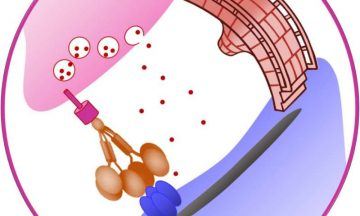From Phys.Org:
 The human brain’s neuronal network undergoes lifelong changes in order to be able to assimilate information and store it in a suitable manner. This applies in particular to the generation and recall of memories. So-called synapses play a central role in the brain’s ability to adapt. They are junctions through which nerve signals are passed from one cell to the next. A number of specific molecules known as synaptic organizing proteins ensure that synapses are formed and reconfigured whenever necessary.
The human brain’s neuronal network undergoes lifelong changes in order to be able to assimilate information and store it in a suitable manner. This applies in particular to the generation and recall of memories. So-called synapses play a central role in the brain’s ability to adapt. They are junctions through which nerve signals are passed from one cell to the next. A number of specific molecules known as synaptic organizing proteins ensure that synapses are formed and reconfigured whenever necessary.
An artificial protein
An international team of researchers has now combined structural elements of such naturally occurring molecules into an artificial protein called CPTX and tested its effect in disease models. To this end, the compound was administered to mice with neurological deficits analogous to human afflictions. Specifically, the tests focused on Alzheimer’s disease, spinal cord injury and cerebellar ataxia—a disease that is characterized primarily by a failure of muscle coordination. All these conditions are associated with damage to the synapses or their loss. The study was a collaborative effort by experts from several research institutions, including the DZNE’s Magdeburg site, MRC Laboratory of Molecular Biology in UK, Keio University School of Medicine in Tokyo, and, also in Japan, Aichi Medical University.
Easing symptoms of disease
“In our lab we studied the effect of CPTX on mice that exhibited certain symptoms of Alzheimer’s disease,” said Prof. Alexander Dityatev, a senior researcher at the DZNE, who has been investigating synaptic proteins for many years. “We found that application of CPTX improved the mice’s memory performance.” The researchers also observed normalization of several important neuronal parameters that are compromised in Alzheimer’s disease, as well as in the studied animal model. Namely, CPTX increased the ability of synapses to change, which is considered as a cellular process associated with memory formation. Furthermore, CPTX was shown to elevate what is called “excitatory transmission.” This is to say that the protein acted specifically on synapses that promoted activity of the contacted cell. And finally, CPTX increased the density of so-called dendritic spines. These are tiny bulges in the cell’s membrane that are essential for establishing excitatory synaptic connections.
